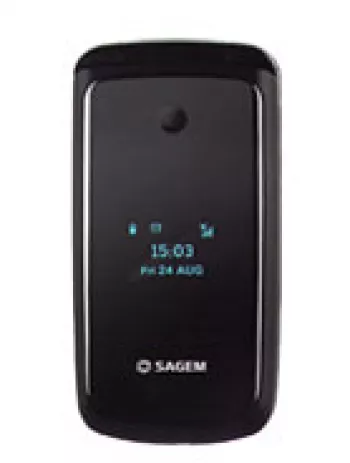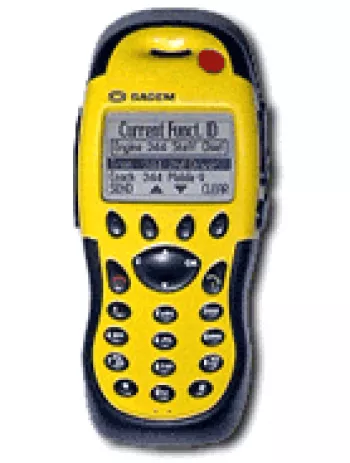
Overview of Sagem MC 3000
The Sagem MC 3000 is a feature phone that was released in 2001. Known for its simplicity and ease of use, this phone was part of the wave of mobile devices that began to embed themselves in everyday life during the early 2000s. Despite its discontinued status, the Sagem MC 3000 remains a nostalgic piece of technology, representing a time when mobile communication was just starting to become mainstream.
Design and Build
The design of the Sagem MC 3000 is characteristic of early 2000s mobile phones. With dimensions of 105 x 45 x 18 mm, and weighing 112 grams, it was considered compact and lightweight for its time. The phone's body accommodated a Mini-SIM card and it had a minimalistic appearance, featuring a monochrome graphic display capable of showing up to 7 lines of text. This straightforward design made navigation and usage directly focused on basic communication functions.
Display
The Sagem MC 3000 came with a monochrome graphic display, typical of phones from that era. Although modern users might find such a display limited, at the time it provided sufficient clarity and contrast for reading messages and contacts. The screen was designed for simplicity and efficiency, emphasizing text over images, as the phone did not support advanced graphics or a camera.
Network and Connectivity
The phone supported GSM technology, operating on 900 and 1800 MHz bands. This made it suitable for use in various regions, offering decent connectivity for basic voice calls and SMS messaging. However, it did not have GPRS or EDGE capabilities, meaning it did not support mobile internet access, which was common among feature phones of that time.
Battery and Power Management
Equipped with a removable NiMH battery with a capacity of 850mAh, the Sagem MC 3000 provided a reasonable balance between usage time and charging needs. It offered a standby time of around 140 hours and a talk time of up to 105 minutes, which was adequate for moderate use throughout the day. The reliance on removable batteries allowed users to carry spares, extending the phone's usability in the field.
Sound and Alerts
For sound, the Sagem MC 3000 utilized a loudspeaker capable of outputting monophonic ringtones. It incorporated vibration alerts, giving users multiple ways to be notified of incoming calls and messages. However, it lacked a 3.5mm headphone jack, which limited personal audio listening options that are common in modern devices.
Memory and Storage
The internal memory of the Sagem MC 3000 was quite limited compared to today's standards. It did not support external storage options such as memory cards, and its phonebook was capable of storing only 40 contacts. Despite its limited capacity, the phone's storage supported essential functions for communication.
Messaging and Communication Features
The phone included basic SMS functionality, which was the primary means of written communication at the time. It lacked advanced email or internet capabilities, reflecting the focus on voice calling and text messaging typical of feature phones during this era.
Other Features
Additional features of the Sagem MC 3000 included a clock and alarm, providing essential daily utilities. It also included a few simple built-in games for entertainment. However, the phone did not support Java, which means it could not handle third-party applications or complex games that became popular in the later years.
Legacy and Impact
While the Sagem MC 3000 was discontinued and succeeded by more technologically advanced models, it remains a symbol of the transitional phase in mobile communication. It serves as a reminder of the industry's early steps towards creating mobile devices that prioritize connectivity and user-friendly design. For those who used it, the phone is often remembered fondly for its robustness and reliability.
Key Features of Sagem MC 3000
- GSM technology supporting dual 2G bands (GSM 900 / 1800)
- Compact and lightweight design (105 x 45 x 18 mm, 112 g)
- Monochrome graphic display supporting up to 7 lines
- Mini-SIM compatibility
- Downloadable monophonic ringtones with vibration alerts
- Pre-installed games for entertainment
- SMS messaging capability
- Basic utilities like clock and alarm
- Removable NiMH battery with up to 140 hours of standby time
Disadvantages of Sagem MC 3000
- No GPRS or EDGE support for data connectivity
- Discontinued status, lack of support, and updates
- Monochrome display with limited resolution (up to 7 lines)
- No memory card slot for expanding storage
- Limited phonebook capacity (only 40 contacts)
- No camera feature
- Lack of 3.5mm audio jack for personal audio experience
- No wireless communication features such as WLAN or Bluetooth
- Absence of positioning features like GPS
- No FM radio functionality
- No USB connectivity for data transfer
- Limited messaging options (only SMS)
- Lack of a web browser
- Short battery talk time (only 105 minutes)
- NiMH battery type, less efficient compared to modern lithium-ion batteries

View Also
More Phones
All Rights Reserved +13916 Phones © Mobilawy 2025

























